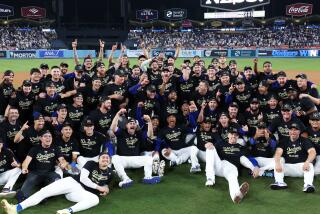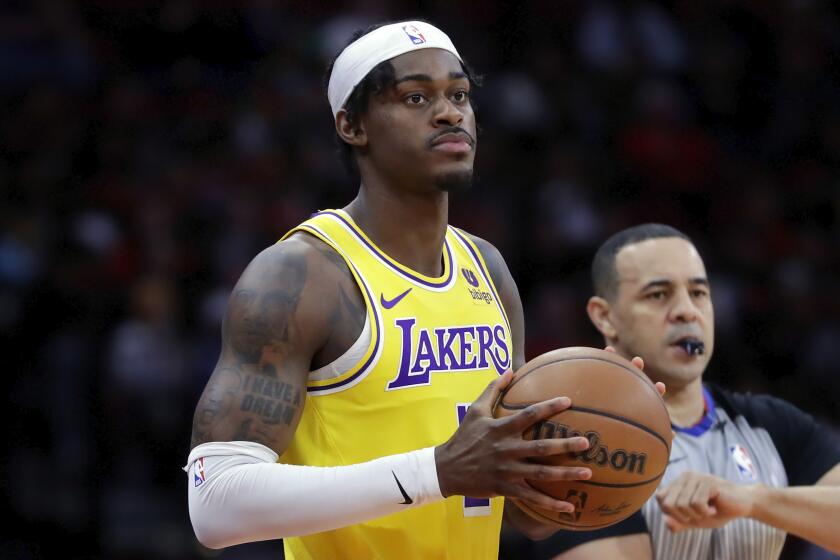GETTING TO KNOW ME . . . : Padres’ Jones Has Struggled to Establish Consistency
- Share via
YUMA, Ariz. — It’s not really an identity crisis. Padre right-hander Jimmy Jones is a perfectly personable 23-year-old Texan with strawberry blond hair, a live arm and a future that’s still as bright as his kilowatt smile.
He has been playing baseball since he was 5, and it’s all he has ever wanted to do. “I’ll keep playing as long as they let me,” he says. “After that, I’ll play softball.”
It’s just that Jones used to be temperamental. And then he was mellow. And then he was skittish. And then he wasn’t tough enough.
It all depended on whom you asked. And everybody seemed to have an opinion.
In the minor leagues, he would pitch 18 scoreless innings and everything would be fine.
Then he would allow a run and all hell would break loose. “I would throw my glove, kick the water cooler . . . Anything that comes to mind about wrecking something,” he says now. “I’d do it.”
The Padres didn’t like that.
“Finally, somehow, I learned to calm down,” Jones said.
That helped him make the major leagues, where he solidified his position in the starting rotation last summer with a 7-4 record during the second half of the season. During one stretch, he won four straight.
But he had trouble holding leads. Suddenly, the word was he wasn’t a “competitor”--that hoary chestnut that drops out of baseball’s cliche tree so often unfairly.
This much was true: He frequently followed a good start with a bad one. The Padres didn’t like that, either.
“And I’ve got to keep my leads,” he says. “If a guy makes a mistake behind me, I’ve got to pitch a little tougher. I’ve got to concentrate on every pitch. Not two of three or three of four.”
Jones’ five-year struggle to emerge from the shadow of Dwight Gooden has been a struggle to be the pitcher the Padres want him to be without betraying the person he is still becoming.
Growing up is hard enough. Growing up under a major league microscope is harder still.
“It seems like I’m two different guys,” he says.
Jones knew the microscope would always be there after the Padres selected him third in the first round of the 1982 June free agent draft. He had been 14-3 his senior year at Dallas’ Thomas Jefferson High School.
The Mets had the next pick. They chose Gooden.
One year later, Gooden was blowing away major league hitters with a fastball that was harder to see than Lincoln’s beard on a bad penny.
During Gooden’s rapid ascent, Jones was fighting a string of injuries while wallowing in Walla Walla, reconnoitering in Reno, beating the bushes in Beaumont and visiting in Vegas.
Gooden found fame overnight. Jones was still looking for himself--or at least the Jimmy Jones everybody else wanted to see.
Despite arm tendinitis in 1983, torn ankle ligaments in 1984 and a damaged knee in 1985, he pitched well. By September of 1986, he was up with the big club. He threw a one-hit shutout against Houston in the Astrodome in his first major league start.
Significantly, the only hit he allowed was a third-inning triple by the opposing pitcher, Bob Knepper. He admits that the sin of letting up may still be his biggest fault.
The night before that game, Jones was so hyper he couldn’t sleep. He went to bed early, punched the pillow all night and was up by 6 a.m. “I was saying, ‘When is it going to be daylight?’ ” he said.
By game time, he was so tired, his body was relaxed. But his mind was still pumped. He had reached the happy medium. “If I had had eight or 10 hours’ sleep, I would have been saying, ‘Let’s go! Let’s go!’ I would have been knocked out in the first inning.”
Instead, he was a knockout. He still is. Sometimes.
Padre pitcher Eric Show sidled up to Jones in the locker room the other day and, apropos of nothing, proclaimed Jones to be “the greatest athlete in the universe.”
But back then, Jones’ one-hitter proved to be a tough act to follow. Gooden, meanwhile, was struggling with a drug problem that would eventually land him in a rehabilitation center.
Jones couldn’t help but notice. He couldn’t help but wonder what would have happened if he, not Gooden, had wound up in the media fishbowl that is New York.
“I don’t know Dwight at all,” Jones says. “I don’t know his personality and I can’t really put myself in that situation because I obviously haven’t been there. But I’m glad I wasn’t thrown to the wolves.
“I think it would have been tough. A guy like Gooden comes along every 30 or 40 years. Maybe. I don’t know if I would have had the same success as him in New York. But if I had, I think it would have been hard. Especially in New York. It’s not terrible there, but it’s tough to survive.”
It might have been even more difficult if the Mets had chosen Jones and he hadn’t been an instant success. Especially if the Padres had used the fourth pick to take Gooden.
But the point in the real world right now is this: Jimmy Jones is still only 23. He pitched well in the major leagues last year. He appears to be finally and completely free of major injury, though he confesses to nagging calcium deposits in his throwing elbow.
He has a manager, Larry Bowa, who will be patient with him but firm at the same time. He has a new pitching coach, Pat Dobson, who says, “The ability’s there.”
“He’s like the rest of our team,” Bowa says. “He needs consistency. It’s hard to pitch in the big leagues with one good, one bad, one good and one bad.”
“I’m sure that’s hard for him (Jones) to live with, too,” Dobson says. “But when you’re managing, it’s even tougher not to be able to count on a guy to give you at least five innings.”
Said Bowa: “Blowing the big leads is just a lack of concentration. You sort of relax mentally.”
Bowa and Dobson will watch every move Jones makes. And Jones knows it. He says he’s ready for it and welcomes it. And maybe, in the final analysis, that’s how the 1988 version of Jimmy Jones differs from the others.
“Larry says it a lot,” Jones says. “I’ve got to be consistent. And he’s absolutely right.”
But the problem isn’t solved yet. Jones spent the better part of three years in the minors curing his temper.
Yet, just the other day, Dobson made this statement: “It may be Jimmy’s nature not to be aggressive. But sometimes you’re gonna have to get a little (upset) and just go for it. Hopefully he’ll be able to do that.”
What Dobson is talking about is controlled aggression. What Jones is looking for is aggressive control. But it’s much more than a matter of semantics. It’s Jones’ life and a large chunk of the Padres’ future.
“This team is going to score runs,” says Keith Moreland, the newly acquired outfielder. “It’s a question of what kind of pitching we get. We’ll know more by the end of spring training.”
Jones, who is seven months older than Gooden, already figures he’ll win between 13 and 15 games this season. He says 20 victories is not out of the question. Bowa says Jones has erased doubts in everybody’s minds that he can pitch at this level.
From a standpoint of mechanics, Dobson says Jones is still too reliant on his fastball. Dobson, who was a minor league pitching instructor for the Mariners last year, remembers his first exposure to Jones. “He threw a two-hit shutout against us and all he used were fastballs,” Dobson says.
He and Bowa are working on Jones’ changeup and curveball. All three are working on his head. There’s nothing wrong with Jones that would concern a doctor or a psychiatrist.
It’s just that a pitcher’s attitude can be as important as his velocity or delivery. Just ask Dwight Gooden.
More to Read
Go beyond the scoreboard
Get the latest on L.A.'s teams in the daily Sports Report newsletter.
You may occasionally receive promotional content from the Los Angeles Times.










